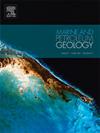Marine flooding induced basinal brine mixing and carbonate cementation: An example from Cretaceous ultra-deep clastic reservoirs in the Kuqa Depression, western China
IF 3.6
2区 地球科学
Q1 GEOSCIENCES, MULTIDISCIPLINARY
引用次数: 0
Abstract
Marine flooding can significantly change hydrochemical features of pore water and provide needed ions for reservoir diagenesis. Present basinal brines and contemporaneous cements may record the participation of paleo-marine flooding. The ultra-deep (>6000 m) sandstone reservoirs of the Cretaceous Bashijiqike Formation (K1bs) in the Kelasu thrust-fold belt, Kuqa Depression of western China, are featured by a CaCl2-type brine and widespread eodiagenetic carbonate cementation. Through a study integrating petrographic characterization, cathodoluminescence imaging, hydrochemical feature comparison, geochemical indicators, carbon and oxygen isotopes and reactive transport simulations, we have concluded that late Cretaceous marine flooding events provided the essential ion source required for carbonate cementation and controlled major-ion compositions of the K1bs brine. There appears to be a complementary spatial distribution of calcite and dolomite cements in K1bs. Calcite cement occurs mainly in the northern paleo-high terrains, which was precipitated from alternating redox conditions due to periodic infiltration of meteoric water. Dolomite cement occurs mainly in the southern paleo-lows, being formed under stable reducing conditions caused by submerged seawater. Calcite precipitation, dolomitization and dissolution of K-feldspar further modified major ionic compositions of the late Cretaceous seawater during burial, leading to the formation of the present CaCl2-type brines in K1bs. Reactive transport modeling showed that high-flux meteoric water can promote calcite deposition, while low-flux meteoric water is beneficial to dolomite deposition. The late Cretaceous marine flooding significantly enhanced the major-ion contents, altered the hydrochemistry of the initial pore fluid and induced carbonate cementation within the terrestrial sandstone reservoirs in the seawater-meteoric water mixing zone.
海相驱入盆地卤水混合与碳酸盐胶结作用——以库车坳陷白垩系超深碎屑岩储层为例
海相驱能显著改变孔隙水的水化学特征,为储层成岩作用提供所需离子。现在的盆地盐水和同时期的胶结物可能记录了古海相洪水的参与。库车坳陷克拉苏逆冲褶皱带白垩系巴什基奇克组(K1bs)超深(>6000 m)砂岩储层以cacl2型卤水和广泛的古成岩碳酸盐岩胶结作用为特征。通过岩石学表征、阴极发光成像、水化学特征对比、地球化学指标、碳氧同位素和反应输运模拟等综合研究,认为晚白垩世海相淹水事件为碳酸盐胶结提供了必要的离子源,并控制了K1bs卤水的主要离子组成。K1bs中方解石和白云石胶结物在空间上呈互补分布。方解石胶结物主要分布在北部古高地,是由于大气水的周期性入渗而形成的交替氧化还原条件。白云石胶结物主要赋存于南部古低地,是在淹没海水的稳定还原条件下形成的。方解石的沉淀、白云化作用和钾长石的溶蚀作用进一步改变了晚白垩世海水的主要离子组成,导致了k1b中现在的cacl2型盐水的形成。反应输运模拟结果表明,高通量大气水有利于方解石沉积,低通量大气水有利于白云岩沉积。晚白垩世海相淹水显著提高了海气混合带陆相砂岩储层的主要离子含量,改变了初始孔隙流体的水化学性质,诱发了碳酸盐胶结作用。
本文章由计算机程序翻译,如有差异,请以英文原文为准。
求助全文
约1分钟内获得全文
求助全文
来源期刊

Marine and Petroleum Geology
地学-地球科学综合
CiteScore
8.80
自引率
14.30%
发文量
475
审稿时长
63 days
期刊介绍:
Marine and Petroleum Geology is the pre-eminent international forum for the exchange of multidisciplinary concepts, interpretations and techniques for all concerned with marine and petroleum geology in industry, government and academia. Rapid bimonthly publication allows early communications of papers or short communications to the geoscience community.
Marine and Petroleum Geology is essential reading for geologists, geophysicists and explorationists in industry, government and academia working in the following areas: marine geology; basin analysis and evaluation; organic geochemistry; reserve/resource estimation; seismic stratigraphy; thermal models of basic evolution; sedimentary geology; continental margins; geophysical interpretation; structural geology/tectonics; formation evaluation techniques; well logging.
 求助内容:
求助内容: 应助结果提醒方式:
应助结果提醒方式:


